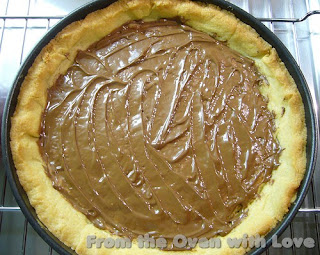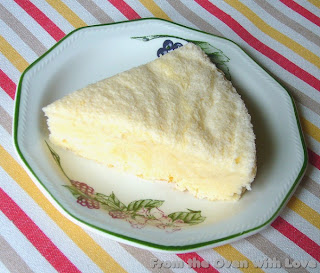The 2010 December Daring Bakers’ challenge was hosted by Penny of Sweet Sadie’s Baking. She chose to challenge Daring Bakers’ to make Stollen. She adapted a friend’s family recipe and combined it with information from friends, techniques from Peter Reinhart’s book.........and Martha Stewart’s demonstration.
Well, it's time for excuses! -_-U
First of all I'll tell you about the stollen. I baked it on Christmas Eve because I intended to give it away to my boyfriend (and because I didn't have anymore time left if I wanted to make it on time). There's only three of us at home and the loaves of stollen were too much, but my boyfriend's home is filled with people on Christmas thus the decision was taken: he recieved his Christmas presents + the big loaf of stollen ^^
One more thing: I hate raisins but my parents and boyfriend love them. This means that when I ate my share of the small loaf I had a hard time avoiding them ^^U
It was pretty easy to make, there aren't any major complaints apart from being a little time-consuming (as any other kind of bread). I didn't have any trouble with the raising time or the kneading so I was really happy!
And, ¿what about the flavour of the loaves? I'm sorry but it was pretty bland. The stollen tasted super with some jam, though. It was my fault because I didn't add enough zest and raisins, apart from not adding any other dried fruits or marzipan.
Oh! and it also tasted good dipped in hot cocoa!
Finally, the excuses for not updating the blog before:
I spent the first 2 weeks of December abroad, concretely I went to New York!!!
And when I came back I found a big pile of work waiting for me! T_T
After that the Cristmas craze came and dragged me along...
And that's all folks!
I wish you a very happy New Year 2011!!!
The recipe:
Ingredients:
60ml lukewarm water (43ºC)
14g active dry yeast
a pinch of salt
240ml milk
140g unsalted butter (you can use salted butter)
770g all-purpose flour
115g sugar
1 teaspoon cinnamon
3 large eggs, lightly beaten
Grated zest of 1 lemon and 1 orange
2 teaspoons vanilla extract
170g firmly packed raisins
3 tablespoons rum
Melted unsalted butter for coating the wreath
Icing sugar for dusting wreath (optional)
Method:
Well, it's time for excuses! -_-U
First of all I'll tell you about the stollen. I baked it on Christmas Eve because I intended to give it away to my boyfriend (and because I didn't have anymore time left if I wanted to make it on time). There's only three of us at home and the loaves of stollen were too much, but my boyfriend's home is filled with people on Christmas thus the decision was taken: he recieved his Christmas presents + the big loaf of stollen ^^
One more thing: I hate raisins but my parents and boyfriend love them. This means that when I ate my share of the small loaf I had a hard time avoiding them ^^U
It was pretty easy to make, there aren't any major complaints apart from being a little time-consuming (as any other kind of bread). I didn't have any trouble with the raising time or the kneading so I was really happy!
And, ¿what about the flavour of the loaves? I'm sorry but it was pretty bland. The stollen tasted super with some jam, though. It was my fault because I didn't add enough zest and raisins, apart from not adding any other dried fruits or marzipan.
Oh! and it also tasted good dipped in hot cocoa!
Finally, the excuses for not updating the blog before:
I spent the first 2 weeks of December abroad, concretely I went to New York!!!
And when I came back I found a big pile of work waiting for me! T_T
After that the Cristmas craze came and dragged me along...
And that's all folks!
I wish you a very happy New Year 2011!!!
The recipe:
Ingredients:
60ml lukewarm water (43ºC)
14g active dry yeast
a pinch of salt
240ml milk
140g unsalted butter (you can use salted butter)
770g all-purpose flour
115g sugar
1 teaspoon cinnamon
3 large eggs, lightly beaten
Grated zest of 1 lemon and 1 orange
2 teaspoons vanilla extract
170g firmly packed raisins
3 tablespoons rum
Melted unsalted butter for coating the wreath
Icing sugar for dusting wreath (optional)
Method:
- In a small bowl, soak the raisins in the rum.
- Pour the warm water into a small bowl, sprinkle with yeast and let stand 5 minutes. Stir to dissolve yeast completely.
- In a small saucepan, combine the milk and the butter over medium-low heat until butter is melted. Let it stand until lukewarm (about 5 minutes).
- Lightly beat eggs in a small bowl and add the vanilla extract.
- In a large mixing bowl, stir together the flour, sugar, salt, cinnamon, orange and lemon zests.
- Then stir in the yeast, eggs and the lukewarm milk mixture. It should be a soft, but not sticky, ball. When the dough comes together, cover the bowl with plastic or a tea cloth and let it rest for 10 minutes.
- Add in the raisins and mix them with your hands to incorporate.
- Sprinkle the counter with flour, then transfer the dough to the counter and begin kneading to distribute the fruit evenly, adding additional flour if needed (the dough should be soft and satiny, tacky but not sticky). Knead for approximately 8 minutes (when the dough is kneaded enough a few raisins will start to fall off).
- Lightly oil a LARGE bowl and transfer the dough to the bowl, rolling around to coat it with the oil. Cover the bowl with plastic wrap and put it in the fridge overnight.
- Let the dough rest for 2 hours after taking out of the fridge in order to warm slightly. Then punch dough down and roll it sightly to make it larger than wider (this is to make a traditional shaped loaf). Fold the dough nearly in half.
- Proof for approximately 2 hours at room temperature, or until about 1 and 1/2 times its original size.
- Preheat oven to 180°C with the oven rack on the middle shelf.
- Bake the stollen for 20 minutes, then rotate the pan 180 degrees for even baking and continue to bake for 20 to 30 minutes.
- Transfer to a cooling rack and brush the top with melted butter while still hot. Immediately tap a layer of powdered sugar over the top through a sieve or sifter. Wait for 1 minute, then tap another layer over the first.





































